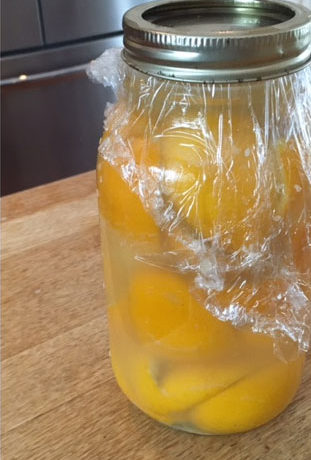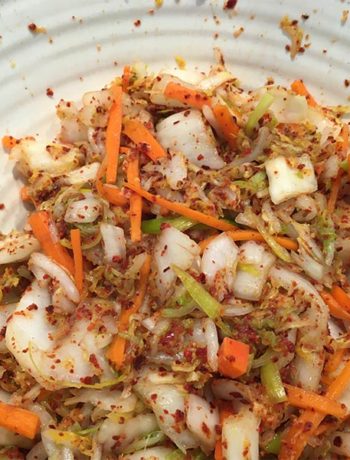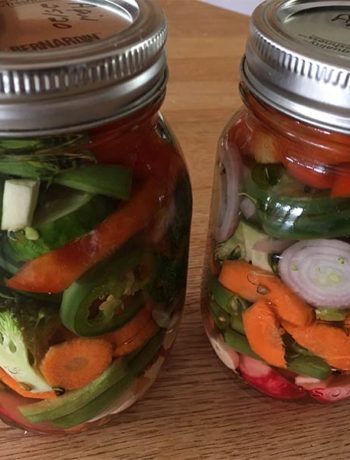As we’re all busy in the kitchen making jams and jellies, I thought it opportune to write about my experience with the “pectin challenge”. I went on a mission to experiment with and learn about pectin. So here we go.
Pectin is a carbohydrate naturally occurring in fruits to varying degrees. Some fruits like lemons and apples are high in pectin while others, like peaches, pears, raspberries are low. Pectin also changes with the ripeness of fruit is. Unripe and over-ripe fruit contain less pectin. There are tests you can do at home to determine the level of pectin. If interested, see my resources section at www.thevalleypreservery.ca.
In order to create a gel in jams or jellies water, sugar and acid are needed in the right proportions for the right amount of time in order for pectin to act like a web holding together the fruit and sugar. Pectin has a negative charge so it will not bind with water unless acid is added. This is why lemon juice is frequently added in jam and jelly recipes in addition to being a flavour amplifier.
Fruits high in pectin can normally be made without added pectin. For example, making apple jelly without commercial pectin is simple and reliable. The set or gel point happens between 217 and 220 F on a candy thermometer depending on altitude. It is also possible to test for doneness using the frozen plate test. Put a small plate in the freezer. When the jam or jelly begins to coat the back of a spoon, place a teaspoon on the frozen plate. If a finger drawn through the mixture leaves a clear trail, it’s ready.
It is possible to add pectin through natural means without turning to the commercial varieties. First, is the traditional long-boil method. Boiling causes pectin chains to be released from the fruit which then combine with sugar and acid to result in the “set”. Another way to naturally enhance pectin is by adding grated Granny Smith apple as is done in recipes from Test Kitchens of America. Finally, you can make your own pectin from apples. The pectin can be water-bath processed for long-term storage and used whenever you are in a jam-making mood.
On the commercial side, there are basically two types of pectin. The first is high methoxyl pectin like regular Certo or Bernardin pectin in powder or liquid form. These pectins are activated by sugar which is why recipes often require a lot of sugar. Newer to the scene are low methoxyl pectins that are activated by calcium rather than sugar. Certo, Bernardin, and others have low or no sugar pectin options. Pomona was first to produce low methoxyl pectin and it is preservative free.
I set out to try these approaches in order to share my results.The disclaimer, of course, is this is my personal opinion!
The long-boil method without added pectin is a purist’s dream. The upside is it requires less sugar. There are two downsides: First, you need the skill of determining the set point either using a candy thermometer or the frozen plate test method. The second downside is that the longer the boil, the more the flavour diminishes. In fact, during my Cornell course, we tested strawberry jam made the traditional long-boil method comparing it to jams made with regular pectin and with freezer jam pectin. The findings were startling. The freezer jam produced the brightest colour and flavour of all! If you have little time and lots of freezer space, by all means make freezer jam. If you are a traditionalist, go for the long-boil method.
As far as high methoxyl commercial pectin goes, I find regular liquid pectin to be great for jellies. There is no risk of getting clumps of undissolved pectin in the jellies and the set seems consistently good. Regular powdered pectin often creates too firm a set for my taste. However, Canadian Living suggests using tablespoons of powdered pectin rather than the whole box and this produces a much nicer set. I have also used the grated apple method recommended by Test Kitchens of America for both peach and raspberry jam, and this too produces excellent texture, flavour and colour. Last year I experimented with Pamona low-methoxyl pectin hoping to become a convert to low sugar pectin with no preservatives. Alas, that didn’t happen. While Pamona requires low levels of sweetener, I didn’t find the texture to be appealing and it does not hold colour over the course of the year. The jam turns brownish. This problem exists for all low methoxyl pectin options. Sugar is simply necessary to hold the colour of the jam/jelly.
The power of pectin is critical to a good jam or jelly. Knowing the pectin levels of fruit you are working with is important and is available in reputable canning cookbooks. The question then is how to enhance pectin when it is required. Whether using a long-cook method, a natural enhancement, or a commercial pectin, all can work well. To some extent it is a matter of personal choice. To another extent, it is a matter of science. Embracing both yields the best results.



